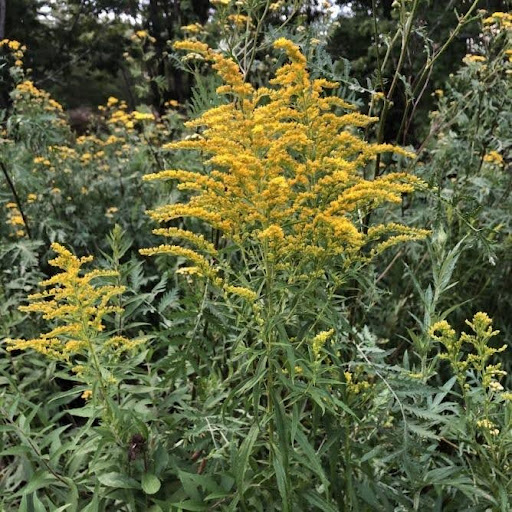Conservation Corner is a weekly article produced by the Forest County Land Conservation and
Land Information Department. For more information contact Lucas O’Brien, Forest County Land
Conservation Technician at 715-478-1387 or by e-mail at
Goldenrod, a striking wildflower native to Northern Wisconsin, is a hallmark of the region’s late summer and early fall landscapes. Its radiant golden blooms blanket meadows, prairies, and open woodlands, creating a scene that captures the essence of the changing seasons. Beyond its visual appeal, goldenrod plays a crucial role in the local ecosystem, offering a wealth of benefits to wildlife and the environment. One of the most common misconceptions about goldenrod is its association with seasonal allergies. Many mistakenly blame goldenrod for hay fever, but this hardy plant is not the culprit. Its pollen is heavy and sticks to the plant, designated to be carried by insects rather than the wind. The true plant that causes hay fever is often ragweed, which blooms at the
same time and release lightweight, airborne pollen. This misunderstanding has unfairly tarnished goldenrod’s reputation, despite its significant ecological contributions. Goldenrod is a lifeline for pollinators, particularly during the late summer months when other nectar sources become scarce. Bees, butterflies, and other insects flock to its bright yellow flowers, drawn by the abundant nectar and pollen. Monarch butterflies, in particular, rely on goldenrod as a critical food source. Birds also benefit from goldenrod, feeding on its seeds and using its foliage for shelter. By supporting such a diverse array of species, goldenrod serves as a keystone plant in Northern Wisconsin’s ecosystems. In addition to its role in supporting wildlife, it also contributes to the health of the
environment. Its deep, fibrous root system helps prevent soil erosion, stabilizing the ground in areas prone to runoff. These roots also improve the soil quality by breaking up compacted earth and cycling nutrients back into the soil. Goldenrod’s ability to thrive in a variety of conditions from dry, sandy soils, to moist, fertile ground makes it a versatile and resilient plant that can adapt to changing climates and landscapes. For gardeners and nature enthusiasts, goldenrod offers a low-maintenance and rewarding addition to any landscape. It thrives in sunny, well-drained areas and pairs beautifully with other native plants like asters, black-eyed Susan’s, and coneflowers. By planting goldenrod, gardeners can create pollinator friendly habitats while enjoying the plants vibrant color and easy care.

